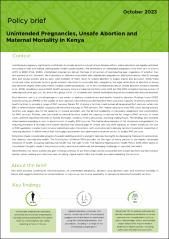| dc.description.abstract | Unintended pregnancy significantly contributes to unsafe abortion in much of sub-Saharan Africa, where abortions are legally restricted.
According to the 2014 Kenya Demographic Health Survey (KDHS), the prevalence of unintended pregnancy rose from 34% in 2014 to
41.9% in 2020 (PMA, 2020). Unintended pregnancies disrupt the lives of all women of reproductive age, regardless of whether they
are married or not. However, the humiliation or dishonor associated with unintended pregnancies disproportionately affects teenage
girls and young women, and as such, vast numbers of them resort to unsafe abortion to evade shame and exclusion. While these
social and other economic factors guide women’s decisions to terminate their pregnancy, the legal restrictions of abortion in Kenya
and abortion stigma often direct them towards unsafe procedures. Up to 14% of pregnancies end in unsafe abortion in Kenya (Mumah
et al., 2014), resulting in about 2600 deaths annually. Kenya’s maternal mortality ratio (362 per 100,000) is highest among women of
peak reproductive age (25–39), and in this group, up to 17% of deaths and severe morbidities may be associated with induced abortion. | en_US |

